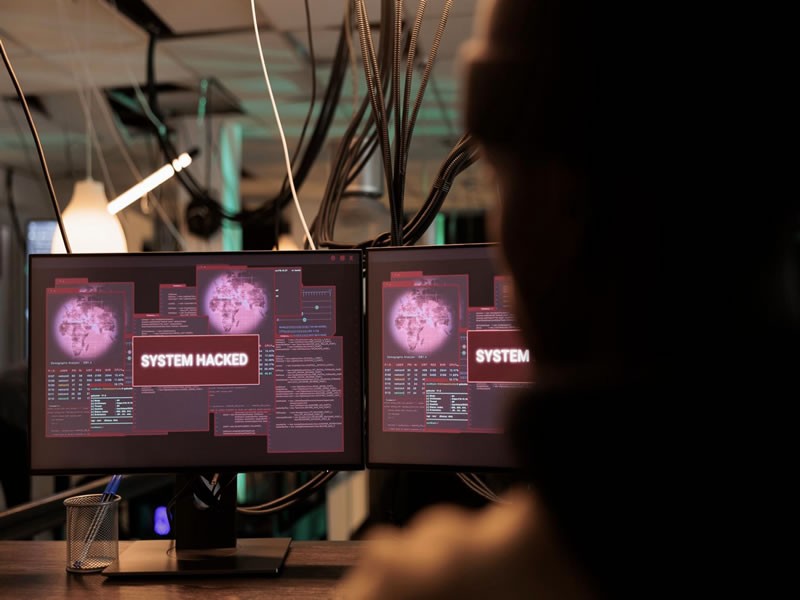Insight Blog
Agility’s perspectives on transforming the employee's experience throughout remote transformation using connected enterprise tools.
14 minutes reading time
(2792 words)
Cybersecurity Trends: 5 Essential Insights Every Business Should Be Aware Of
Stay ahead in the ever-evolving digital landscape, fortify your defenses, and safeguard your business from emerging cyber threats.
In our interconnected digital age, the realm of cybersecurity is more critical than ever. As technology advances, so do the tactics employed by cyber threats. Every day, businesses face an evolving landscape of challenges that demand vigilance and proactive measures to safeguard sensitive information, maintain trust, and ensure uninterrupted operations.
According to the 2022 ENISA report on the threat landscape in the EU, a staggering 10 terabytes of data are pilfered every month. Enhancing both your comprehension of cybersecurity and adopting best practices stands out as a crucial means to stay ahead in this digital age. In 2020, malicious attacks targeting key sectors in Europe witnessed a twofold increase, a trend that has persisted, according to the European Union's Cybersecurity Agency (ENISA).
However, the enigmatic aura surrounding cybersecurity remains a hurdle, impeding businesses from proactively addressing this pressing concern.
There is an intensified emphasis on educating individuals about their online behavior and fortifying their preparedness against cybersecurity threats, a need that has never been more pressing. This holds particularly true for businesses. With the proliferation of cyberattacks, it becomes imperative, first and foremost, to recognize that a fundamental understanding of key trends and processes can significantly fortify your business's defenses.
So proactive measures are essential to staying ahead of evolving challenges and mitigating risks. By embracing security programs that actively research trends, develop innovative tools, and shield against emerging threats, your business can transition towards a more cyber-secure way of operating.
In this blog, we delve into "Cybersecurity Trends: 5 Essential Insights Every Business Should Be Aware Of." From emerging threats to innovative defense strategies, join us on a journey to explore the key trends shaping the cybersecurity landscape and discover how businesses can stay ahead in the ongoing battle against cyber adversaries.
What is Cybersecurity?
From a business perspective, cybersecurity is a comprehensive strategy and set of practices designed to protect a company's digital assets, information, and technology infrastructure from unauthorized access, attacks, and potential threats. It encompasses a range of measures and protocols aimed at ensuring the confidentiality, integrity, and availability of sensitive data and systems.
Key Aspects of Cybersecurity in a Business Context:
- Protection of Data - Safeguarding sensitive and confidential data, including customer information, financial records, and proprietary business data, is a fundamental aspect of cybersecurity. This protection is vital for maintaining trust with customers and partners.
- Prevention of Unauthorized Access – Implementing measures to prevent unauthorized access to digital systems and networks. This involves securing user accounts, employing strong authentication methods, using tools like the real-time IP address geolocation API by IPinfo to detect and block suspicious login attempts, and controlling access permissions to sensitive information.
- Threat Detection and Response - Establishing mechanisms for the early detection of cyber threats and implementing rapid response strategies. This includes monitoring network activities, analyzing security logs, and deploying tools to identify and mitigate potential threats.
- Business Continuity and Resilience - Developing plans and protocols to ensure business continuity in the event of a cyber incident. This involves creating backup systems, disaster recovery plans, and resilience strategies to minimize the impact of disruptions.
- Compliance with Regulations - Adhering to cybersecurity regulations and standards relevant to the industry. Many sectors have specific compliance requirements, and businesses must implement measures to meet these standards and avoid legal repercussions.
- Employee Education and Training - Recognizing that employees play a crucial role in cybersecurity, businesses invest in education and training programs. Ensuring that staff is aware of security best practices, potential threats, and their role in maintaining a secure environment.
- Vendor and Supply Chain Security - Extending cybersecurity measures to include vendors and partners. Businesses assess and monitor the cybersecurity practices of their supply chain to mitigate the risk of third-party vulnerabilities.
- Continuous Improvement and Adaptation - Acknowledging that the cybersecurity landscape is dynamic, businesses engage in continuous improvement efforts. This involves staying informed about emerging threats, adopting new technologies, and adapting security measures to evolving risks.
In essence, cybersecurity from a business perspective is an integral component of risk management and operational stability.
Types of Cyber Threats
- Malware - Malware, a contraction of malicious software, is an umbrella term encompassing various harmful software forms, including viruses, worms, and trojan horses. These programs pose threats by infiltrating, damaging, or disrupting computer systems, leading to potential data theft and unauthorized access by hackers.
- Ransomware - Ransomware, a distinct subtype of malware, encrypts a victim's data, making it inaccessible until a ransom is paid. These attacks have surged in frequency, impacting businesses, governments, and individuals alike, resulting in significant financial and operational repercussions.
- Phishing - Phishing attacks are a form of social engineering in which cybercriminals employ deceptive emails, text messages, or website links to manipulate users into divulging sensitive information, such as login credentials or personal data. This acquired information can then be exploited for fraudulent activities, identity theft, or unauthorized access to systems.
It is a proactive approach to safeguarding valuable assets, maintaining trust with stakeholders, and ensuring the resilience and longevity of the business in an increasingly digitized and interconnected world.
Impact of Cyberattacks on Businesses
- Financial Repercussions: The aftermath of a cyberattack often inflicts substantial financial burdens on businesses. Immediate expenditures include remediation efforts like hiring cybersecurity experts, recovering or replacing compromised systems, and, in some cases, meeting ransom demands. Long-term financial implications may encompass lost revenue due to downtime, legal expenses, and fines incurred for non-compliance with data protection regulations.Extension: Business continuity planning becomes paramount in mitigating financial losses. Implementing resilient strategies and investing in cybersecurity measures can help fortify defenses, reducing the financial impact of potential cyber threats.
- Reputational Challenges: A cyberattack has the potential to inflict severe damage on a company's reputation, eroding trust among customers, partners, and investors. This loss of trust can translate into a decline in business, creating hurdles in attracting new customers or securing vital investments.Extension: Proactive communication and transparency are key in reputation management post-cyberattack. Companies must adopt measures to rebuild trust, demonstrate enhanced cybersecurity practices, and assure stakeholders of their commitment to data protection.
- Operational Disruptions: Cyberattacks wield the power to cause significant operational disruptions, ranging from systems downtime to the loss of critical data. Such disruptions impede a company's capacity to deliver products and services, adversely impacting customer satisfaction and potentially leading to contractual penalties.Extension: To minimize operational disruptions, businesses should focus on robust cybersecurity measures, regularly update systems, and institute effective incident response plans. This proactive approach ensures a swift recovery and minimizes the negative operational consequences of a cyber incident.
As the digital landscape evolves, businesses must recognize the multifaceted impact of cyberattacks. GuidePoint Security emphasizes addressing these consequences through a comprehensive approach, integrating financial planning, reputation management, and strategies to keep operations resilient despite evolving cybersecurity threats.
The Rise of Cyberthreats
Cyberattacks, with their primary goal of accessing individual or enterprise-level data for financial gain, pose significant risks in today's interconnected world. At the individual level, these attacks can lead to compromised credit card information or, even more alarmingly, complete identity theft. On an enterprise scale, cyber threats often target sensitive customer data or critical operational information, impacting not only the organization directly involved but also the wider community.
Industries crucial to our daily lives, such as energy and healthcare, face the ripple effects of cyberthreats, affecting a broader population. Identifying these cyberthreats is a challenging task as they often operate in covert ways.One prevalent technique is phishing, where cybercriminals send deceptive emails, masquerading as trustworthy sources to trick individuals into revealing sensitive information. Beyond phishing, more sophisticated techniques include ransomware attacks, the introduction of malware, and the manipulation of individuals through social engineering tactics.
The increasing prevalence of cyberthreats can be attributed to hackers constantly devising new ways to bypass existing cybersecurity systems.
The increasing prevalence of cyberthreats can be attributed to hackers constantly devising new ways to bypass existing cybersecurity systems.
The cybersecurity industry, recognizing the evolving nature of these threats, is stepping up to meet the challenge.
As the digital landscape becomes more intricate, cybersecurity professionals are deploying advanced technologies, enhancing threat detection mechanisms, and implementing robust defense strategies to safeguard individuals, enterprises, and critical sectors from the escalating risks posed by cyberattacks. Staying one step ahead in this dynamic cybersecurity landscape is crucial, and the industry is dedicated to adapting and fortifying defenses against the ever-evolving tactics employed by cybercriminals.
Why is Cybersecurity important?
Securing your business in the digital age is paramount, not only for protecting sensitive data but also for safeguarding your hard-earned reputation. Stephane Nappo, Global Head of Information Security at Société Générale, aptly remarked that, "It takes 20 years to build a reputation and a few minutes of a cyber-incident to ruin it." Cybersecurity is not merely a shield against reputation damage; it is a crucial defense mechanism to shield your profits and foster sustainable growth. Alarmingly, a staggering 83% of small to medium-sized businesses are financially unprepared to recover from a cyberattack, underscoring the urgency for proactive prevention measures.
Prevention, indeed, is superior to remediation. While the realm of cybersecurity may seem complex and intimidating, adopting protective measures is more accessible than perceived. Numerous straightforward practices can fortify your business's cybersecurity posture, ranging from recognizing and reporting phishing attempts to implementing stronger password policies and regularly updating software.
A notable revelation is that a substantial 95% of cybersecurity breaches stem from human error. However, rather than viewing this as a vulnerability, businesses can perceive it as an opportunity for improvement. Simple modifications to processes, comprehensive support and education for employees, and staying abreast of cybersecurity trends can significantly enhance overall security.
To empower you and your team in navigating the ever-evolving landscape of cybersecurity, here are 5 key trends that demand attention. These trends not only shed light on emerging threats but also provide valuable insights into how your business can proactively adapt and fortify its defenses in the face of evolving cyber risks.
Emerging Trends in Cybersecurity: A Comprehensive Overview of 5 Key Developments
1. Consumer Demand for Cybersecurity
In the current landscape, cybersecurity transcends internal organizational concerns; it has become a crucial aspect of consumer expectations.
Modern buyers are exceptionally mindful of the security of their personal data and its responsible utilization. Recent surveys highlight that 9 out of 10 consumers consider mobile security as their top priority.
Within the surveyed group, 84% of business executives believe that customers hold a high level of trust in the company. However, a mere 27% of customers share the same sentiment. For businesses, this entails not only upholding robust cybersecurity measures internally but also effectively communicating these credentials externally to build and maintain consumer trust.
Addressing this paradigm shift requires businesses to adopt a holistic approach that not only fortifies internal cybersecurity practices but also emphasizes transparent communication with consumers.
Establishing and showcasing a commitment to data security not only fosters customer trust but also positions businesses as responsible custodians of sensitive information in an era where digital trust is paramount.
2.The Ascendancy of Ransomware Threats
The proliferation of ransomware malware marks a significant cybersecurity challenge, targeting systems by encrypting files and coercing victims into paying a ransom for the decryption key required to restore their data access. Essentially, it restricts user access to specific applications until the demanded ransom is paid.
This form of cyberattack has emerged as a prevalent and conspicuous threat in recent years, and forecasts from Forbes indicate a potential exacerbation of this trend in the future. However, combating ransomware can be significantly bolstered by ensuring that all personnel within your company install the latest security systems and diligently keep them up to date, thereby mitigating vulnerabilities that these attacks often exploit.
Given the escalating sophistication of ransomware attacks, a proactive cybersecurity stance is essential. Regular employee training on recognizing phishing attempts, implementing robust backup strategies, and adopting advanced endpoint protection are integral components of an effective defense strategy against ransomware.
Furthermore, staying informed about evolving ransomware tactics and investing in cybersecurity measures that proactively detect and neutralize these threats are crucial steps in fortifying an organization's resilience against this ever-evolving cybersecurity menace.
Follow us and access great exclusive content everyday: Follow us on Google News
3.Cybersecurity Challenges Amidst Remote Work Trends
The paradigm shift to remote work, accelerated by the global pandemic, has introduced a host of cybersecurity challenges, as highlighted in Microsoft's recent Digital Defence Report.
This transition has widened the attack surfaces available to cybercriminals, particularly with the integration of home devices into professional environments. These newly created vulnerabilities often catch employees unaware, emphasizing the need for enhanced awareness and security measures.
The surge in remote working necessitates a multifaceted approach to cybersecurity.
Comprehensive employee training becomes imperative to equip staff with the knowledge to identify and address potential threats. Simultaneously, businesses can implement innovative processes to enhance remote security.
4.Elevating Cybersecurity to Boardroom Priority
The surge in cyberattacks has fundamentally reshaped the dynamic between IT security teams and executive leadership within organizations. In a fictional context, a majority of leaders at TechGuard Enterprises now consider cybersecurity attacks among their top three primary concerns, signaling a paradigm shift in prioritization.
A recent survey conducted by CyberShield Software revealed that an overwhelming 88% of the Board of Directors at SecureTech Solutions perceive cybersecurity as a critical business risk, underscoring the profound impact of cyber threats on corporate strategies.
Recognizing the strategic importance of cybersecurity, Paul Proctor, CyberShield Software's research vice president, emphasizes that it is no longer solely an IT concern but a broader business issue that demands attention from executives beyond the IT department. Proactive entities, such as InnovateSecure Corporation, are already embracing this perspective.
Projections indicate that by 2025, a significant transformation is expected, with at least 50% of C-level executives having performance requirements directly linked to cybersecurity.
This shift signifies a collective responsibility to safeguard the enterprise, where cybersecurity is woven into the fabric of business strategy, fostering a resilient and secure digital environment. As organizations navigate this evolving landscape, aligning leadership goals with cybersecurity imperatives is crucial for staying ahead of the intricate challenges posed by the cybersecurity landscape.
You may also like: Best Apps for Employees: UPDATED 2022 – A Complete Guide
5.Cybersecurity's Integral Role in ESG Initiatives
In the realm of ESG (Environmental, Social, and Governance) initiatives, the significance of cybersecurity is undergoing a noteworthy evolution.
Often associated with sustainability, the 'S' in ESG encompasses broader aspects such as diversity, inclusion, fair pay, social justice, workplace safety, consumer safety, as well as data protection and privacy. Within the fictitious context of ResponsibleTech Corporation, the imperative to enhance ESG credentials includes a dedicated focus on robust cybersecurity practices.
While the 'E' (Environmental) and 'G' (Governance) aspects of ESG are integral, the growing importance of cybersecurity within the 'S' (Social) domain is undeniable. Recognizing this, CyberGuard Solutions anticipates a significant shift in organizational priorities. Projections suggest that by 2026, a substantial 30% of large organizations, including SustainableEnterprises Ltd., will publicly disclose ESG goals specifically centered around cybersecurity – a notable increase from the mere 2% reported last year.This surge reflects the evolving understanding that cybersecurity is not only a business imperative but also a fundamental component of responsible and ethical corporate practices. As organizations strive to bolster their ESG initiatives, the inclusion of robust cybersecurity goals emerges as a critical step towards achieving a holistic and socially responsible business model.
Free ebook: How To Get Your Intranet Off The Ground
Wrapping up
The landscape of cybersecurity is evolving, and employee communication platforms play a pivotal role in fortifying digital defenses.
AgilityPortal, is a cutting-edge employee communication app, emerges as a powerful tool in averting security threats within the organizational framework.
As we navigate the dynamic cybersecurity terrain, AgilityPortal is not just a communication app; it is a proactive shield against potential threats.
By fostering secure and encrypted channels for internal communication, AgilityPortal ensures that sensitive information remains protected from unauthorized access. In this digital age, where cyber threats are ever-present, our app's multifaceted approach includes robust authentication processes and continuous monitoring, mitigating the risk of data breaches.
The foresight embodied in AgilityPortal aligns seamlessly with the evolving needs of organizations.
By instilling a culture of cybersecurity awareness and providing a secure platform for communication, it not only safeguards valuable information but also contributes to the overall resilience of the organizational ecosystem. In an era where the intersection of technology and security is paramount, AgilityPortal stands as a testament to our commitment to providing a secure and efficient communication environment for businesses.
Read more: Cybersecurity: 5 Key Trends in Cloud-Based Intranet Security and Access Control
Categories
Blog
(2584)
Business Management
(318)
Employee Engagement
(204)
Digital Transformation
(171)
Intranets
(119)
Growth
(117)
Remote Work
(61)
Sales
(48)
Collaboration
(37)
Culture
(29)
Project management
(29)
Customer Experience
(26)
Knowledge Management
(21)
Leadership
(20)
Comparisons
(5)
Ready to learn more? 👍
One platform to optimize, manage and track all of your teams. Your new digital workplace is a click away. 🚀
Free for 14 days, no credit card required.














